Explore the Best AI Image Gallery

The Future of Graphic Design: How AI is Shaping the Landscape
Artificial Intelligence (AI) is making significant strides in various industries, and graphic design is no exception. Designers are beginning to harness AI technologies like never before, leading to productivity enhancements, innovative design possibilities, and even new creative paradigms. In this blog post, we will explore the impact of AI on the graphic design industry, its potential uses, ethical considerations, and future trends that are likely to shape the industry.
AI's Impact on the Creative Industry
The integration of AI into graphic design has led to remarkable changes in the creative landscape. Traditionally, graphic designers relied heavily on their skills, experience, and creativity. However, with the advent of AI tools like Adobe Sensei, Canva's Magic Resize, and Autodesk's generative design capabilities, designers can now streamline their workflows, automate repetitive tasks, and focus on more strategic and creative aspects of their projects. Here are some of the notable impacts:
- Enhanced Efficiency: AI algorithms can automate tedious tasks such as resizing images, generating layouts, and even suggesting design elements based on the user's preferences. This capability significantly reduces the time spent on these repetitive functions, allowing designers to dedicate more time to artistic endeavors.
- Inspiration Generation: With the use of AI, designers can draw inspiration from vast databases of images and styles, allowing them to experiment with new combinations and designs that they may not have considered otherwise.
- Personalization: AI can analyze user data and preferences in real time to help create personalized designs tailored to specific audiences, enhancing user engagement and satisfaction.
Potential Uses of AI in Graphic Design
The applications of AI in graphic design are expansive and continue to grow. Here are some notable uses:
- Logo Design: Platforms like Looka and Hatchful utilize AI to create logos quickly. Users input their business details, and the AI generates multiple logo options based on design principles and trends.
- Image Editing: Tools like Luminar AI allow for automated adjustments to enhance images, enabling designers to achieve professional results without extensive editing knowledge.
- Content Generation: With advancements in natural language processing, AI can assist in generating design briefs, social media content, and even marketing copy, providing designers with a holistic approach to their projects.
Ethical Considerations in AI-Driven Design
With the rapid integration of AI into graphic design, several ethical dilemmas have surfaced that merit consideration:
- Creativity vs. Automation: As AI continues to evolve, the line between human creativity and algorithm-generated designs is becoming increasingly blurred. This raises questions about the value of human creativity in art and design.
- Intellectual Property: If an AI system creates a unique piece of design, who owns the rights? This ambiguity complicates legal frameworks and artistic ownership.
- Job Displacement: With increased automation, there is concern regarding job security for graphic designers. While AI assists in creating efficiencies, it may also lead to workforce reductions in certain areas.
Future Trends in AI and Graphic Design
As we look to the future, several trends are emerging in the intersection of AI and graphic design:
- Augmented Design: AI tools are expected to become more sophisticated, leading to augmented design systems where designers collaborate with AI as a partner rather than a tool. This collaborative dynamic could yield unprecedented creative possibilities.
- Data-Driven Design: The reliance on data analytics in understanding user behavior will play a significant role in shaping design decisions. AI will enable designers to make informed choices based on insights gathered from various metrics.
- AI as a Design Mentor: The future might see AI systems evolving into mentors for designers, providing feedback and guidance based on best practices, which can foster skill development and creativity.
In conclusion, AI is reshaping the graphic design landscape by improving efficiency, creativity, and personalization. While there are several advantages to embracing this technology, ethical implications must also be thoughtfully considered to ensure a balance between innovation and the preservation of human creativity. By navigating these complex dynamics, the future of graphic design, enhanced by AI, promises to be an exciting frontier filled with endless possibilities.
![**ultra detailed 8k cinematic black and white beauty portrait of a young woman from chest up, vertical frame, face, hands and hair filling the composition, smooth neutral grey studio background with soft dark vignette on the edges, center of the frame is her eye, lips and finger in a "shh" gesture oval symmetrical face with soft but well defined features, ultra smooth flawless skin, no pores, no wrinkles, perfect beauty retouch, straight elegant nose with soft highlight along the bridge and gentle shadow under the tip full sensuous lips with a sharp cupid’s bow, slightly parted, a thin bright glossy highlight strip on the lower lip emphasizing volume, subtle light reflection on the lip gloss one eye visible through a gap between fingers, other eye mostly hidden by the upper hand, long thick eyelashes like fake lashes, small bright catchlight in the pupil, upper eyelid with smoky eye makeup, darker tone along lash line fading smoothly towards the brow, dark thick well shaped eyebrows, gently arched, not overdramatic dark wavy hair, big glossy waves falling down, one clear S-shaped wave on the right side of the frame, soft highlights along the strands to show texture, hair swept away from the cheeks so the face is not covered both hands in thin semi-transparent black gloves up to the forearm, upper hand placed horizontally across the upper face, back of the hand towards camera, fingers slightly spread so that one finger is above the brows and another lower finger creates a narrow gap that reveals the eye, fingertips long and tapered, sharp stiletto-like nails visible under the sheer fabric, subtle darker seams along the fingers and glove edges lower hand bent so that the index finger is vertical and gently touching the center of the lips in a classic "shhh" pose, [...]** - Image #4 <@1264899319799222315>](https://images.ai-img.art/thumbnails/150/8507c113aa12343ebd50af4ab9c637a6cf1acf21c55772271eb6a66bb04fa39c.webp)
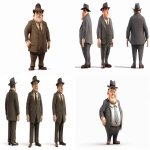
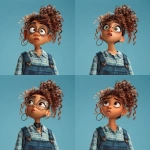




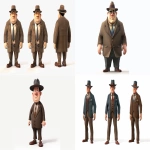
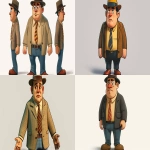

](https://images.ai-img.art/thumbnails/150/f3411154f4c743a26f102ecfc985f3f6214e93b285748fac66c88f3b52f85b26.webp)
](https://images.ai-img.art/thumbnails/150/7c4350a99935771fe343a7ae65c780cf4cd6b861e69cdc32bd58a3a92fb2476f.webp)
](https://images.ai-img.art/thumbnails/150/4f3d83c4b1d979b5be00f4ea80d67b71c0335bc1163e692d738e553ac37709e5.webp)


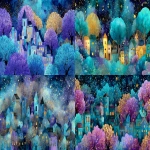
](https://images.ai-img.art/thumbnails/150/1871c145bfe0276c6e1bacf6ec0da6d2dae71370bf71674589af29a201acdd5f.webp)


](https://images.ai-img.art/thumbnails/150/e07ad2e7379a835127482b0fd3176192c001c90e68a85b4315cf482b6a3f5ea5.webp)
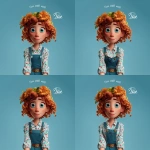


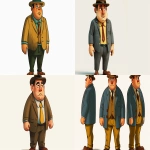


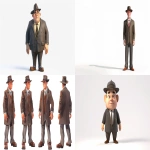

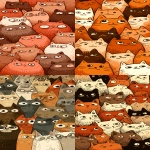

![**ultra detailed 8k cinematic black and white beauty portrait of a young woman from chest up, vertical frame, face, hands and hair filling the composition, smooth neutral grey studio background with soft dark vignette on the edges, center of the frame is her eye, lips and finger in a "shh" gesture oval symmetrical face with soft but well defined features, ultra smooth flawless skin, no pores, no wrinkles, perfect beauty retouch, straight elegant nose with soft highlight along the bridge and gentle shadow under the tip full sensuous lips with a sharp cupid’s bow, slightly parted, a thin bright glossy highlight strip on the lower lip emphasizing volume, subtle light reflection on the lip gloss one eye visible through a gap between fingers, other eye mostly hidden by the upper hand, long thick eyelashes like fake lashes, small bright catchlight in the pupil, upper eyelid with smoky eye makeup, darker tone along lash line fading smoothly towards the brow, dark thick well shaped eyebrows, gently arched, not overdramatic dark wavy hair, big glossy waves falling down, one clear S-shaped wave on the right side of the frame, soft highlights along the strands to show texture, hair swept away from the cheeks so the face is not covered both hands in thin semi-transparent black gloves up to the forearm, upper hand placed horizontally across the upper face, back of the hand towards camera, fingers slightly spread so that one finger is above the brows and another lower finger creates a narrow gap that reveals the eye, fingertips long and tapered, sharp stiletto-like nails visible under the sheer fabric, subtle darker seams along the fingers and glove edges lower hand bent so that the index finger is vertical and gently touching the center of the lips in a classic "shhh" pose, [...]** - Image #2 <@1264899319799222315>](https://images.ai-img.art/thumbnails/150/d87499f6bdc5a4a822aea4674654f70073b052542a1aaa1d08461a13ca2e07f9.webp)
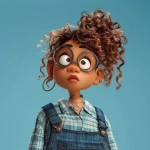


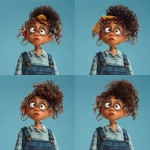
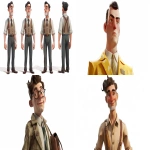
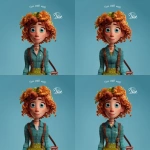
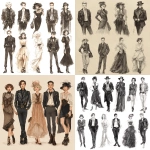
![**ultra detailed 8k cinematic black and white beauty portrait of a young woman from chest up, vertical frame, face, hands and hair filling the composition, smooth neutral grey studio background with soft dark vignette on the edges, center of the frame is her eye, lips and finger in a "shh" gesture oval symmetrical face with soft but well defined features, ultra smooth flawless skin, no pores, no wrinkles, perfect beauty retouch, straight elegant nose with soft highlight along the bridge and gentle shadow under the tip full sensuous lips with a sharp cupid’s bow, slightly parted, a thin bright glossy highlight strip on the lower lip emphasizing volume, subtle light reflection on the lip gloss one eye visible through a gap between fingers, other eye mostly hidden by the upper hand, long thick eyelashes like fake lashes, small bright catchlight in the pupil, upper eyelid with smoky eye makeup, darker tone along lash line fading smoothly towards the brow, dark thick well shaped eyebrows, gently arched, not overdramatic dark wavy hair, big glossy waves falling down, one clear S-shaped wave on the right side of the frame, soft highlights along the strands to show texture, hair swept away from the cheeks so the face is not covered both hands in thin semi-transparent black gloves up to the forearm, upper hand placed horizontally across the upper face, back of the hand towards camera, fingers slightly spread so that one finger is above the brows and another lower finger creates a narrow gap that reveals the eye, fingertips long and tapered, sharp stiletto-like nails visible under the sheer fabric, subtle darker seams along the fingers and glove edges lower hand bent so that the index finger is vertical and gently touching the center of the lips in a classic "shhh" pose, [...]** - Image #3 <@1264899319799222315>](https://images.ai-img.art/thumbnails/150/4c03a422708b372b43caaee1e2929933c40f0a13dc069beeeb228a60b126223b.webp)
![**ultra detailed 8k cinematic black and white beauty portrait of a young woman from chest up, vertical frame, face, hands and hair filling the composition, smooth neutral grey studio background with soft dark vignette on the edges, center of the frame is her eye, lips and finger in a "shh" gesture oval symmetrical face with soft but well defined features, ultra smooth flawless skin, no pores, no wrinkles, perfect beauty retouch, straight elegant nose with soft highlight along the bridge and gentle shadow under the tip full sensuous lips with a sharp cupid’s bow, slightly parted, a thin bright glossy highlight strip on the lower lip emphasizing volume, subtle light reflection on the lip gloss one eye visible through a gap between fingers, other eye mostly hidden by the upper hand, long thick eyelashes like fake lashes, small bright catchlight in the pupil, upper eyelid with smoky eye makeup, darker tone along lash line fading smoothly towards the brow, dark thick well shaped eyebrows, gently arched, not overdramatic dark wavy hair, big glossy waves falling down, one clear S-shaped wave on the right side of the frame, soft highlights along the strands to show texture, hair swept away from the cheeks so the face is not covered both hands in thin semi-transparent black gloves up to the forearm, upper hand placed horizontally across the upper face, back of the hand towards camera, fingers slightly spread so that one finger is above the brows and another lower finger creates a narrow gap that reveals the eye, fingertips long and tapered, sharp stiletto-like nails visible under the sheer fabric, subtle darker seams along the fingers and glove edges lower hand bent so that the index finger is vertical and gently touching the center of the lips in a classic "shhh" pose, [...]** - Image #1 <@1264899319799222315>](https://images.ai-img.art/thumbnails/150/ff5a24c7c060f5350508823c406c28c9596aea4e37eefb60abc0f37504a37383.webp)

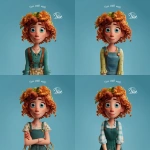
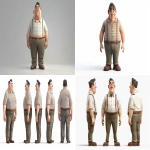
](https://images.ai-img.art/thumbnails/150/5487dcbcab0cd5702a67cc6819342ef56c05d0fc7730bfb7718ee291f10c3da3.webp)
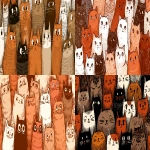

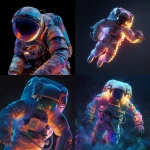
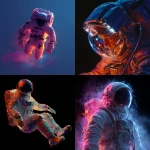

](https://images.ai-img.art/thumbnails/150/d08f607caf4a5c380defef68b778febb8911e8e51e51927b09ed67880bd3084b.webp)